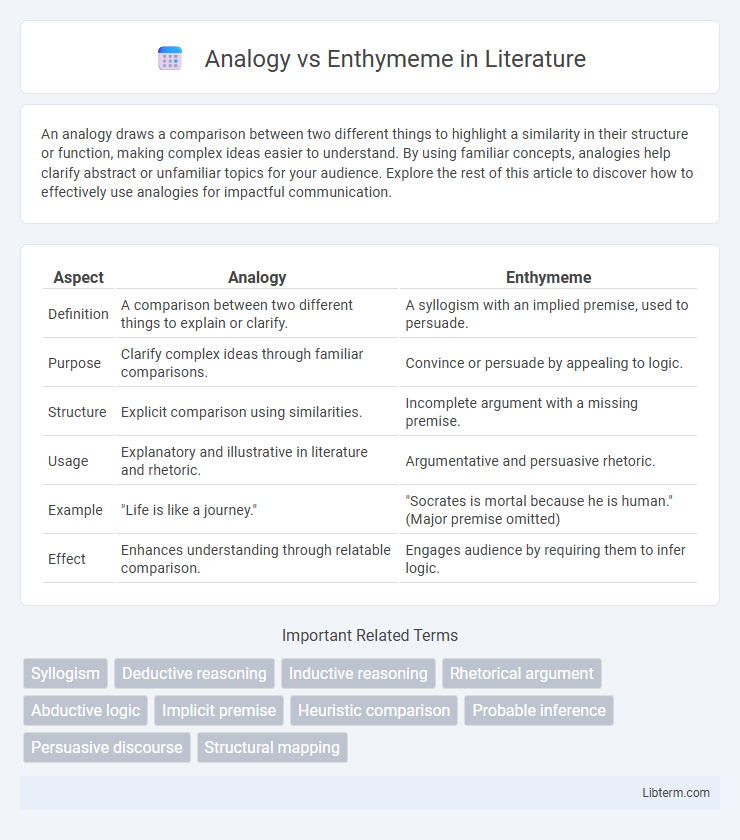An analogy draws a comparison between two different things to highlight a similarity in their structure or function, making complex ideas easier to understand. By using familiar concepts, analogies help clarify abstract or unfamiliar topics for your audience. Explore the rest of this article to discover how to effectively use analogies for impactful communication.
Table of Comparison
| Aspect | Analogy | Enthymeme |
|---|---|---|
| Definition | A comparison between two different things to explain or clarify. | A syllogism with an implied premise, used to persuade. |
| Purpose | Clarify complex ideas through familiar comparisons. | Convince or persuade by appealing to logic. |
| Structure | Explicit comparison using similarities. | Incomplete argument with a missing premise. |
| Usage | Explanatory and illustrative in literature and rhetoric. | Argumentative and persuasive rhetoric. |
| Example | "Life is like a journey." | "Socrates is mortal because he is human." (Major premise omitted) |
| Effect | Enhances understanding through relatable comparison. | Engages audience by requiring them to infer logic. |
Understanding Analogy and Enthymeme
Analogy involves comparing two different concepts to highlight similarities, helping to clarify complex ideas by relating them to familiar ones. Enthymeme is a rhetorical syllogism where one premise is implied rather than explicitly stated, requiring the audience to fill in the gap for persuasive effect. Understanding analogy enhances comprehension by making abstract notions concrete, while grasping enthymeme sharpens critical thinking by recognizing implicit arguments.
Defining Analogy: Key Characteristics
Analogy is a rhetorical device that draws a comparison between two different things based on their similar features, enhancing understanding by illustrating unfamiliar concepts through familiar ones. Its key characteristics include establishing a relationship of similarity, facilitating logical reasoning, and supporting persuasive arguments by making abstract or complex ideas more relatable. Unlike enthymeme, which is a condensed syllogism with an implied premise, analogy explicitly connects two analogs to clarify or explain a point.
Exploring Enthymeme: An Overview
Enthymeme is a form of rhetorical argument that relies on implied premises or conclusions, distinguishing it from analogy, which draws comparisons between two different concepts to clarify or persuade. Enthymemes engage the audience by inviting them to infer missing information, enhancing persuasive impact through shared assumptions. This method is particularly effective in argumentation and discourse, as it actively involves the audience's reasoning process.
Historical Contexts of Analogy and Enthymeme
Analogy originated in classical rhetoric as a tool to explain unfamiliar concepts by comparing them to known ideas, with roots tracing back to Aristotle's "Rhetoric." Enthymeme, also introduced by Aristotle, functions as a persuasive syllogism where one premise is implied rather than stated, reflecting the cognitive context of ancient Greek debates and legal arguments. Both devices were central in shaping rhetorical education during the Renaissance and Enlightenment, influencing modern logical and linguistic studies.
Structural Differences Between Analogy and Enthymeme
Analogy compares two distinct concepts by highlighting shared similarities to explain or clarify an idea, typically structured as a relationship of parallel elements. Enthymeme functions as a truncated syllogism, relying on an unstated premise commonly accepted by the audience, thus creating a persuasive argument through implied reasoning. The structural difference lies in analogy's explicit comparative framework versus enthymeme's reliance on assumed premises and partially expressed logic.
Functions of Analogy in Argumentation
Analogy functions in argumentation by illustrating complex or unfamiliar concepts through comparison with familiar examples, enhancing audience comprehension and persuasion. It facilitates the transfer of understanding between domains, enabling the audience to infer conclusions based on shared attributes between the compared entities. Unlike enthymeme, which relies on implicit premises within syllogistic reasoning, analogy explicitly bridges gaps in knowledge by highlighting relational similarities to support argumentative claims.
Roles of Enthymeme in Rhetorical Reasoning
Enthymemes serve as essential tools in rhetorical reasoning by enabling audiences to actively participate in constructing arguments through implied premises, making communication more engaging and persuasive. Unlike analogies, which clarify unfamiliar concepts by comparison, enthymemes condense logical reasoning into incomplete syllogisms, prompting listeners to fill in gaps based on shared knowledge or beliefs. This interactive reasoning process strengthens persuasion by aligning conclusions with audience expectations and cultural context.
Common Examples of Analogy vs. Enthymeme
An analogy compares two different things to highlight a similarity, such as "Just as a sword is the weapon of a warrior, a pen is the weapon of a writer," illustrating how writing serves as a tool for expression like a sword does in battle. An enthymeme, often found in everyday arguments, is a truncated syllogism such as "He must be a good athlete because he runs fast," where the unstated premise is that all fast runners are good athletes. These examples demonstrate how analogy clarifies concepts through comparison, while enthymemes rely on implied reasoning to persuade.
Strengths and Weaknesses: Analogy vs Enthymeme
Analogy excels in simplifying complex ideas by drawing clear comparisons, making abstract concepts more relatable but can falter when the similarities are superficial or misleading. Enthymeme offers strength in persuasive rhetoric by enabling audiences to fill in missing premises, fostering active engagement, though it risks ambiguity or misinterpretation due to its implicit nature. Analogy's weakness lies in potential overgeneralization, while enthymeme's depends on the audience's shared knowledge and logical reasoning skills.
Choosing Between Analogy and Enthymeme in Writing
Choosing between analogy and enthymeme in writing depends on the purpose and audience; analogy clarifies complex ideas by drawing comparisons to familiar concepts, enhancing understanding through relatable examples. Enthymeme, a form of truncated syllogism, engages readers by prompting them to fill in implied premises, fostering critical thinking and active participation. Writers should select analogy to simplify explanations and enthymeme to persuade by involving readers in logical inference.
Analogy Infographic

 libterm.com
libterm.com